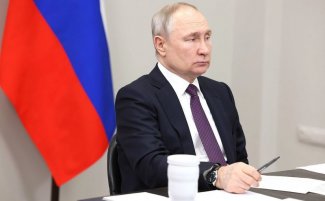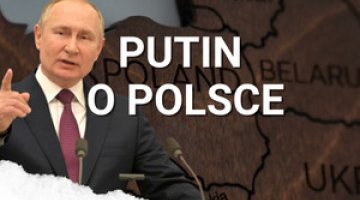Putin threatens to deploy nuclear weapons in Belarus. Day 396 of the war

On 25 March, President Vladimir Putin announced that the construction of a storage facility for tactical nuclear weapons in Belarus would be completed by 1 July, and the training of personnel to handle the nuclear weapons stored there would begin on 3 April. He said that the Iskander missile systems which had been handed over to the Belarusian army would be used to carry the missiles. He made it clear that Russia plans to deploy the nuclear weapons for its own use, not putting them under Belarus’s control. According to Putin, this step was taken in response to the United Kingdom’s promise to supply Ukraine with depleted uranium-based tank shells. He also claimed that Belarus had insisted on the deployment of Russian tactical nuclear weapons on its territory for some time already. The media have reported that nuclear aerial bombs may also be deployed in this country. The reports were based on last year’s announcement that Belarusian aircraft would be adapted to carry tactical nuclear weapons.
The frequency of Russian attacks has decreased on all fronts. According to the Ukrainian General Staff, a total of 204 attacks took place on 24–26 March. After repeated unsuccessful attempts to break through the Ukrainian defences in the area of the M03 main road from Bakhmut to Slavyansk, Russian forces have discontinued their efforts. On the other hand, they have renewed their attacks on Chasiv Yar from two directions, north-east (Bohdanivka) and south-west (Stupochky, Predtechyne); this is a sign that the aggressor has become stronger on the western side of the Donets-Donbas Canal. In Bakhmut, the Russians reportedly have made further advances in the industrial area in the north as well as the south of the town. The very centre and the western part of Bakhmut remain under Ukrainian control. In total, the aggressor’s troops have launched 16–18 attacks per day in recent days in and around the town, compared to 30–50 in the previous weeks.
Russia’s unsuccessful attacks aimed at breaking through the Ukrainian defences north and west of Avdiivka resulted in an attempt to expand their area of operations northwards (Keramik and Novokalynove). The Russian troops made slight progress in the arc west of Donetsk, pushing the defenders in Marinka and on its outskirts, and approaching Krasnohorivka to the north of Marinka (Krasnohorivka is a town in Donetsk oblast, not to be confused with the Krasnohorivka located north of Avdiivka which the Russians occupied in previous weeks). The clashes between Kreminna and Siversk and north-east of Kupiansk have not brought any changes. The heaviest fighting was seen in Synkivka, which is located eight kilometres from the town centre.
The Russian missile attacks were focused on the Ukrainian-controlled part of Donetsk oblast, Kramatorsk being the main target. This city was shelled for three days in a row. Sloviansk and Avdiivka also came under fire. The authorities in Avdiivka announced the evacuation of municipal service employees, the shutdown of mobile communications, and a ban on journalists and volunteers entering the city. Russian artillery and air forces continued shelling and bombing the defenders’ positions and hinterland along the contact lines and in the frontier areas, including in Chernihiv oblast, which had suffered fewer attacks in recent times. Although the shelling of Kherson has become less intense (the frequency has fallen to just a few attacks per day), the local authorities are urging the remaining residents to leave.
On 26 March, the spokesman for the State Border Guard Service of Ukraine announced that the number of Russian soldiers in Belarus had been reduced to about 4000. These troops are still reportedly participating in exercises with the Belarusian army and/or undergoing training before leaving for the front in Ukraine. In previous months there had been on average about 10,000 soldiers in Belarus, most of whom joined the invading army after completing their training.
The new package of German military support for Kyiv includes 100 MG3 machine guns, spare parts for tanks and armoured fighting vehicles, and Pionierpanzer 2 Dachs armoured engineering vehicles. They are expected to arrive in Ukraine at the end of March or later. The UK’s Ministry of Defence has announced that Ukrainian soldiers have completed their training on Challenger 2 tanks.
On 25 March, the founder of the Wagner Group Yevgeny Prigozhin announced that after the expiry of their six-month contracts, more than 5000 criminal mercenaries had been released from service and been granted amnesty as promised. Given the fact that the greatest number of prisoners were recruited to the Wagner Group between July and November 2022, another wave of amnesties should be expected in the coming weeks.
According to unofficial reports, Colonel General Rustam Muradov, who had served as the commander of the Eastern Military District operating in the south of Ukraine since last summer, has been dismissed. Muradov has been blamed for the embarrassing defeat at Vuhledar in January-February this year, when Russian troops suffered huge losses while still failing to break through the Ukrainian defences. His dismissal has been well received by several of the semi-official Russian propaganda channels (the so-called voyenkors).
The Security Service of Ukraine (SBU) announced the detention of more agents of the Russian secret services involved in collecting data on military facilities and critical infrastructure. The SBU discovered a network of agents that had been reporting information about the movements of the Ukrainian army in Kharkiv and Donetsk oblasts since the first days of the war; one of these agents was an assistant to a parliamentary deputy from the Donbas. More such people have been arrested in recent days, including an employee of the Motor Sich plant in Zaporizhzhia (Ukraine’s most important manufacturer of aircraft engines).
Commentary
- Putin’s announcement concerning the deployment of tactical nuclear weapons in Belarus in retaliation for London’s plans to send depleted uranium-based tank ammunition to Ukraine (which cannot even be used in nuclear weapons) is another attempt to force Western countries to reduce their military support for Kyiv. The announced date for completing the nuclear munitions storage facility should be treated as the date when the Russian ‘peace offer’ will expire. If the West’s reaction does not satisfy Russia, their mutual relations will become even more strained.
- The deployment of tactical nuclear weapons in Belarus follows on from the transfer of Iskander systems to the Belarusian army, and will most likely take place regardless of the stance which the West chooses to adopt. The tactical nuclear warheads will be assigned to each missile unit of the Russian land forces and stored in the area of their deployment (as is the case with the Iskander systems of the 152nd Missile Brigade in Kaliningrad oblast). It is worth noting that the Belarusian army is only the operator of the systems; the Russian command will ultimately decide on their use (even if the appearance of joint command within the Regional Grouping of Forces is maintained). In this case, Moscow’s use of tactical nuclear weapons in Belarus as a deterrent to the West is quite unusual; typically, Russia would have deployed the weapons without publicising the fact.
- The deployment of tactical nuclear weapons in Belarus will not translate into a higher risk of their use in the Ukraine war; in the current military situation this is out of the question. What it really represents is further proof of Belarus’s incorporation into the Russian military space. This was an easy move for Moscow because Belarus had constitutionally renounced its status as a nuclear-free state (in February 2022), and thus allowed for the possibility of deploying Russian nuclear weapons on its territory.





